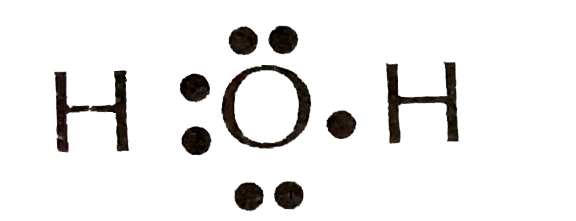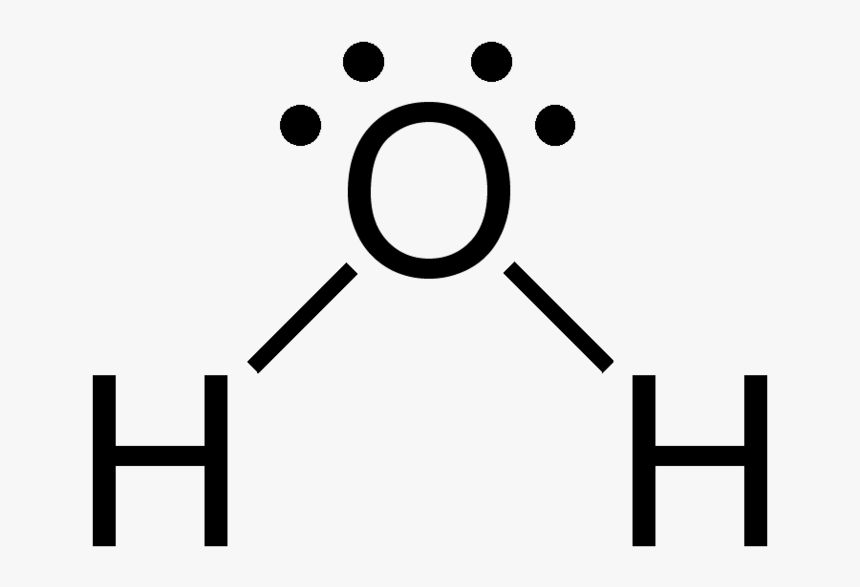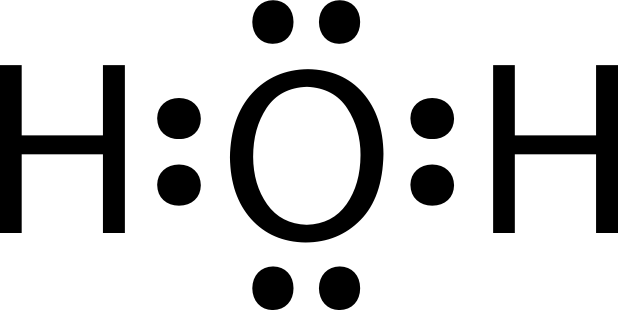
The correct electron dot structure of water molecule is :
(A)

(B)

(C)

(D)

Answer
513.4k+ views
Hint: The atomic number of oxygen is 8. So, we can say that there are 6 valence electrons. And the atomic number of hydrogen is 1. So, the number of valence electrons is 1.
Complete step by step answer:
The electronic configuration of oxygen is 2, 6. So there are 6 valence electrons available for oxygen in order to form a chemical bonding. Similarly, the electronic configuration of hydrogen is 1. So, there is 1 valence electron available for hydrogen in order to form a chemical bonding.

In the diagram, provided above we get an idea about the structure of water molecules.
Oxygen atom has 6 valence electrons out of which 2 valence electrons are involved in bonding with the 2 hydrogen atoms. Therefore, a water molecule has 2 bond pairs of electrons and 2 lone pair (non-bonded) pairs of electrons.
So, we can say that the Lewis dot structure of of water molecule is:

Therefore, corresponding to the question, we can that the correct Lewis dot structure of water molecules is number 3.
So, Option C is the correct answer.
Note:
(1) Lewis structures also known as Lewis dot structures or electron dot structures are diagrams that represent the valence electrons of an atom within a molecule. These Lewis symbols are Lewis structures which help visualize the valence electrons of atoms and molecules, whether they exist as lone pairs or within bonds.
(2) In order to draw the Lewis dot structure, place any remaining lone electron pairs on the central atom. Usually, electronegative atoms will have lone pairs on them. The number of electrons placed on the molecule should correspond to the total number of valence electrons of the atoms in the molecule.
Complete step by step answer:
The electronic configuration of oxygen is 2, 6. So there are 6 valence electrons available for oxygen in order to form a chemical bonding. Similarly, the electronic configuration of hydrogen is 1. So, there is 1 valence electron available for hydrogen in order to form a chemical bonding.

In the diagram, provided above we get an idea about the structure of water molecules.
Oxygen atom has 6 valence electrons out of which 2 valence electrons are involved in bonding with the 2 hydrogen atoms. Therefore, a water molecule has 2 bond pairs of electrons and 2 lone pair (non-bonded) pairs of electrons.
So, we can say that the Lewis dot structure of of water molecule is:

Therefore, corresponding to the question, we can that the correct Lewis dot structure of water molecules is number 3.
So, Option C is the correct answer.
Note:
(1) Lewis structures also known as Lewis dot structures or electron dot structures are diagrams that represent the valence electrons of an atom within a molecule. These Lewis symbols are Lewis structures which help visualize the valence electrons of atoms and molecules, whether they exist as lone pairs or within bonds.
(2) In order to draw the Lewis dot structure, place any remaining lone electron pairs on the central atom. Usually, electronegative atoms will have lone pairs on them. The number of electrons placed on the molecule should correspond to the total number of valence electrons of the atoms in the molecule.
Recently Updated Pages
JEE Atomic Structure and Chemical Bonding important Concepts and Tips

JEE Amino Acids and Peptides Important Concepts and Tips for Exam Preparation

Electricity and Magnetism Explained: Key Concepts & Applications

Chemical Properties of Hydrogen - Important Concepts for JEE Exam Preparation

JEE Energetics Important Concepts and Tips for Exam Preparation

JEE Isolation, Preparation and Properties of Non-metals Important Concepts and Tips for Exam Preparation

Trending doubts
JEE Main 2026: Application Form Open, Exam Dates, Syllabus, Eligibility & Question Papers

Derivation of Equation of Trajectory Explained for Students

Hybridisation in Chemistry – Concept, Types & Applications

Understanding the Angle of Deviation in a Prism

Understanding Collisions: Types and Examples for Students

How to Convert a Galvanometer into an Ammeter or Voltmeter

Other Pages
NCERT Solutions For Class 11 Chemistry Chapter 7 Redox Reaction

JEE Advanced Marks vs Ranks 2025: Understanding Category-wise Qualifying Marks and Previous Year Cut-offs

NCERT Solutions ForClass 11 Chemistry Chapter Chapter 5 Thermodynamics

Thermodynamics Class 11 Chemistry Chapter 5 CBSE Notes - 2025-26

Equilibrium Class 11 Chemistry Chapter 6 CBSE Notes - 2025-26

Ideal and Non-Ideal Solutions Explained for Class 12 Chemistry




